“You have to go out; you don’t have to come back”
Unofficial Coast Guard motto
September 8, 2018
A few months back, you may recall that we stopped into the Old Harbor Lifesaving Station while we were visiting the Cape Cod National Seashore. One of the reasons for that visit was to see how a tour of a maritime museum is conducted. Our tour guide, a National Park Service volunteer named David, inspired us with his ability to portray what life in the U.S. Life Saving Service was like. While we were there, he gave us a tip to go see a famous Coast Guard boat that was docked in Rock Harbor, some 30 miles to the south. It was the subject of a movie called The Finest Hours.
This turned out to be a case where history stared us right in the face and we didn’t catch it.
The next day, we set off to explore Cape Cod’s elbow, first visiting Chatham, and then Rock Harbor. At Chatham, we parked in front of the Coast Guard station and lighthouse. This complex overlooks the Chatham Bars, a series of sandbars that extend out into the ocean.
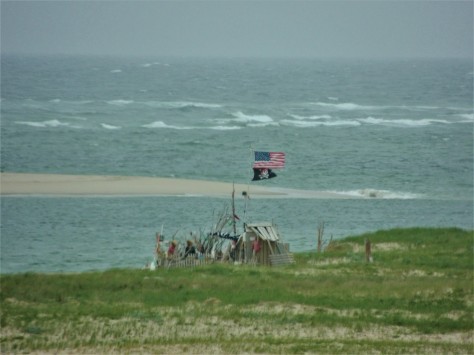
We were a bit more focused on this shack constructed along the shore, but we did note how far out the waves were breaking on the ever-changing sand bars. Shortly after taking this photo, a driving rain came in off of the ocean, so we failed to photograph the station and lighthouse. Instead, we headed up to Rock Harbor to see the boat that David had mentioned. Once at the dock, we were greeted by this sign:
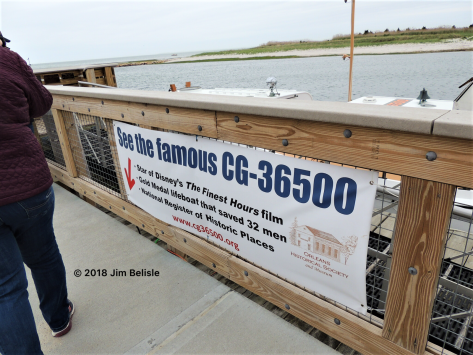
Still not familiar with the story or the film The Finest Hours, we descended to the lower dock to examine the boat.
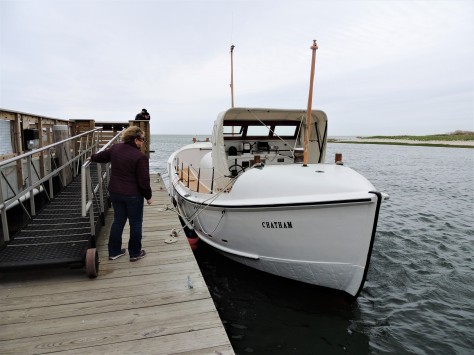
Obviously well restored and impressive to look at, the CG-36500 was tied up with little explanation to it’s storied past, short of the fact that it was a gold medal boat that had saved 32 men. Not knowing much about Coast Guard history, we focused on how impeccable this boat was and not much else.
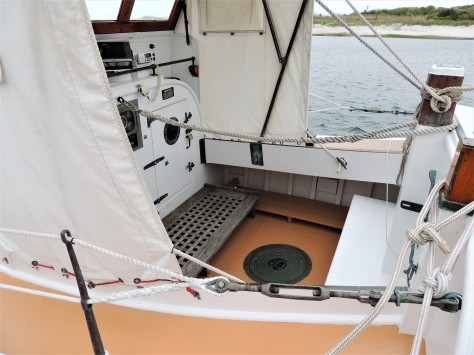
The fittings on the craft were impressive. Still, we were somewhat more interested in the U.S. Life Saving Service on this trip than the Coast Guard, so this small beauty’s story didn’t fully grab our attention. We left the dock with the intention to see the movie and to research the boat’s story. One thing led to another, and that didn’t happen.
Fast forward to our boat museum in the former Glen Haven Canning Company building at Sleeping Bear Dunes National Lakeshore. When we started our stint as volunteers here at the beginning of August, it was hard not to notice the largest boat in the museum as being similar to the CG-36500 we saw in Massachusetts back in May.
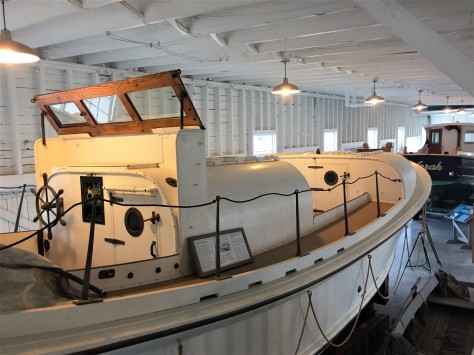
Turns out it was not only similar, but built from the same blueprint. Our boat, the CG-36527, had been stationed at Duluth, Minnesota.
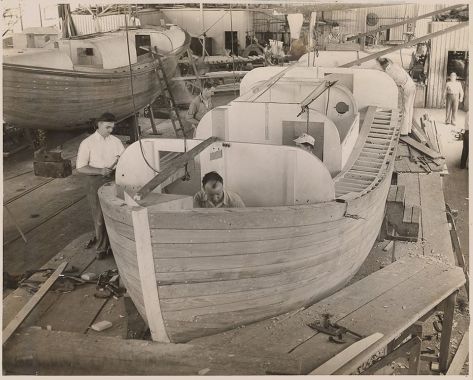
Both crafts, along with the 128 sister TRS 36-foot motor lifeboats, were built by hand at the Curtis Bay Yard in Maryland.
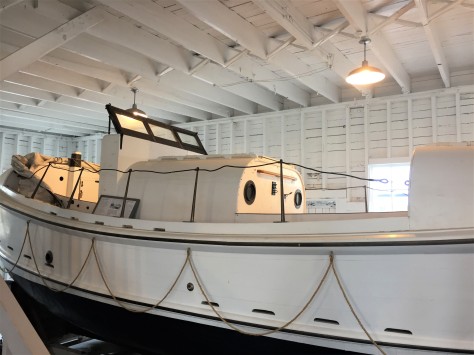
Not being in the water, it appeared much larger than it’s fleetmate out on Cape Cod. The boat is self-bailing, self-righting, 10 tons and its motor will run upside down. Solid as a stone and virtually unsinkable. It is rated to carry a crew of four and up to twelve survivors.
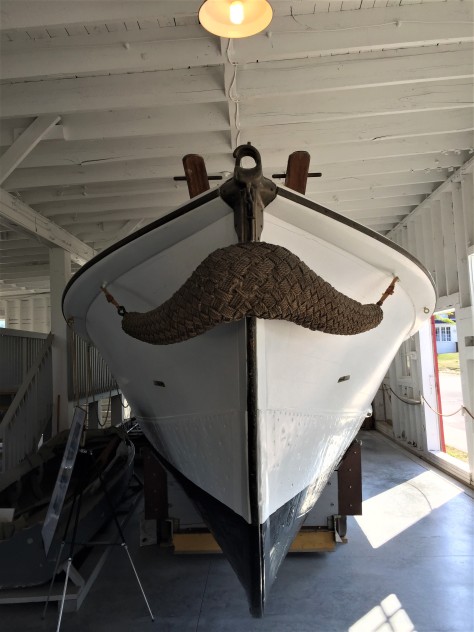
The ‘pudding’ bumper on the front is a work of art. Visitors comment that it resembles a mustache.
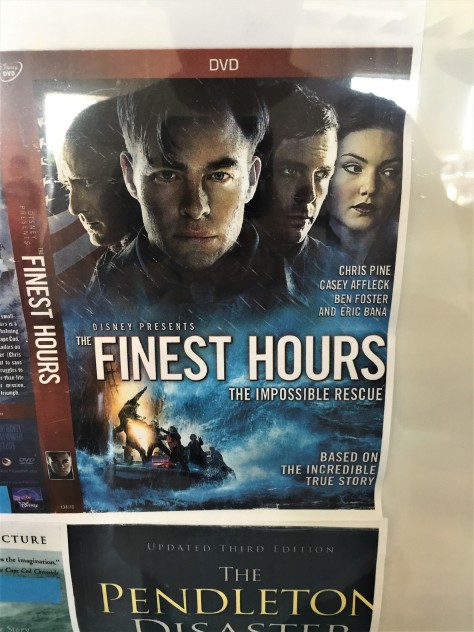
Standing on an easel by the front of the craft, this poster is displayed.
There’s that movie we failed to see…
So we watched the movie, then read the book of the same title. The story goes like this: A ferocious winter storm off the coast of Cape Cod in February of 1952 caught two World War II era tankers in its grip. Both ships split in two between their bows and sterns. The Fort Mercer was able to get a distress call off, and the Coast Guard sent most of their boats to assist in rescuing that ship’s crew. The Pendleton wasn’t able to get an SOS off before it broke up, and it wasn’t until they were noticed on radar that the Chatham stationmaster Daniel Cluff went into action. He ordered Boatswain’s Mate Bernie Webber to gather three other men and head out in the CG-36500 to see if there were any survivors. Doing so meant they had to cross the dangerous Chatham Bars that we mentioned earlier. Those sandbars have been known to rip boats to pieces in mild seas, and the waves that afternoon were upwards of 60 feet high! Most of the locals considered it impossible.
“You have to go out; you don’t have to come back.”
Crossing the bar meant timing the waves, gunning the throttle on the upside and switching to full reverse throttle down the backside…so as to keep from driving the bow into the sand. The ship’s compass was ripped loose and lost overboard almost immediately and the windshield was shattered. Miraculously, they made it past the bars, but they were now running purely on Webber’s knowledge of the currents and the winds. They somehow found the stern of the Pendleton, which was still afloat. On deck were 33 men, anxious to get off. (It was discovered later that the bow section had partially sank, killing the captain and crew that were in it.)
Remember, the CG-36500 is rated to carry a crew of four and up to twelve survivors.
Suddenly, a Jacob’s ladder was thrown over Pendleton’s stern and the men started down. Webber brought the little lifeboat in close to get each man, backing away in between to keep from smashing into the tanker’s side. Men were packed into the survivor’s cabin and onto every available space on deck. The only man that didn’t make it was Tiny Myers, the ship’s 300 pound cook. He fell into the sea and a wave threw the lifeboat into him, killing him. Once everyone was on board, Webber pointed the CG-36500 back towards shore, hoping to beach it somewhere. The tide had risen and they were able to cross the bars rather quickly. As luck would have it, they ended up at the mouth of Chatham Harbor and were able to come directly into the dock with their soaked and freezing survivors.
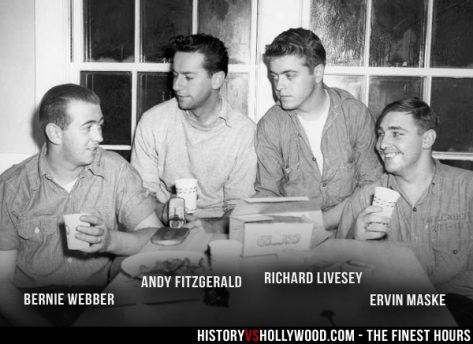
All four crew members were awarded the Gold Lifesaving Medal for their efforts. They tested CG-36500’s limits, which in turn performed beyond its intended purpose for them. The mission is considered to be the Coast Guard’s greatest small boat rescue ever. The craft continued to serve until it was decommissioned in 1968. It was donated to the Cape Cod National Seashore with the intention that it would be displayed in a museum. Funds never materialized, and the boat was left to rot in a storage yard, totally exposed to the elements. The Orleans Historical Society acquired it in 1981 and restored it to the operational beauty it is today.
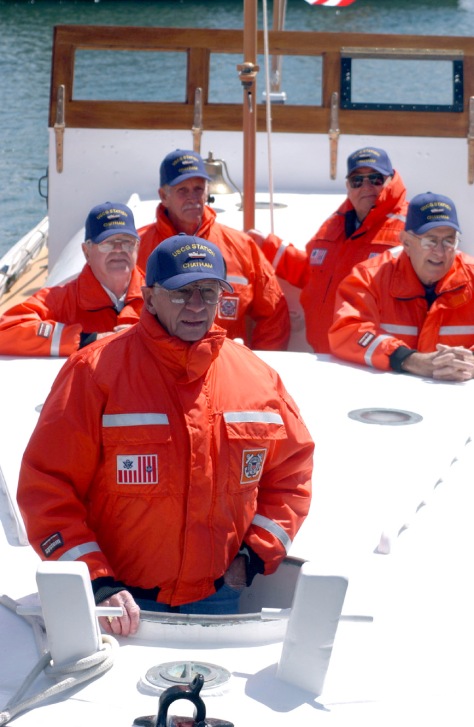
In 2002, the crew was reassembled for the 50th anniversary of the rescue, and they were able to take the CG-36500 out for a tour of the harbor with Webber at the helm.. That would have been a sight to see. Clockwise from the front: Andy Fitzgerald, Richard Livesey, Charles Bridges (Pendleton crewmember who later joined the Coast Guard), Ervin Maske and Bernie Webber.
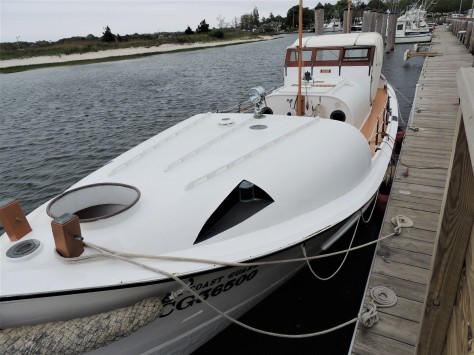
If you find yourself on Cape Cod, be sure to stop in Rock Harbor and view this wonderful piece of history. Maybe rent the movie or read the book. Or if you find one of the 15 or so remaining 36 footers that grace our nation’s maritime museums, take a moment to imagine that night in 1952 when the Coast Guard witnessed their finest hours.
Until next time, safe and happy travels to all!

That’s a great story. Thanks for sharing.
LikeLiked by 1 person
You are welcome, Gaelyn!
LikeLiked by 1 person
Very cool Jim! Now we have to see the movie and we can say that we at least saw the one in Glen Haven.
LikeLiked by 1 person
I’m surprised I didn’t notice it was similar on your post, Dianne and Steve!
https://steveanddiannesmostexcellentadventure.blogspot.com/2018/07/saturday-july-14-2018-northport-michigan.html
LikeLike
We recently saw that movie so when you mentioned the boat I was able to follow right along. Quite the story and bit of history!
LikeLiked by 1 person
Fantastic, Jim! Couple of Disney additions to the real story: the makeshift tiller was fictional. As if the story wasn’t exciting enough. 😉 Also, Miriam and Bernie were already married at the time of the rescue. She was home sick with the flu. That wouldn’t have made for good Hollywood. Her daughter did mention that the producers nailed her mom’s spunk though. 🙂
LikeLike
How wonderful!! That big boat was my favorite when we visited, and the braiding on that “mustache” is amazing. I don’t think we’ll have time to see the famous one when we’re in Cape Cod (if weather allows our visit), but I love the story and will keep it on my list for return trips!
LikeLiked by 1 person
It’s my favorite also, Jodee! If you are in Orleans on US-6, the CG-36500 is a couple miles west on Rock Harbor Road. Google Maps has a pinpoint on it. 🙂
LikeLike
Very interesting & informative. Enjoyed. Thank you
LikeLiked by 1 person